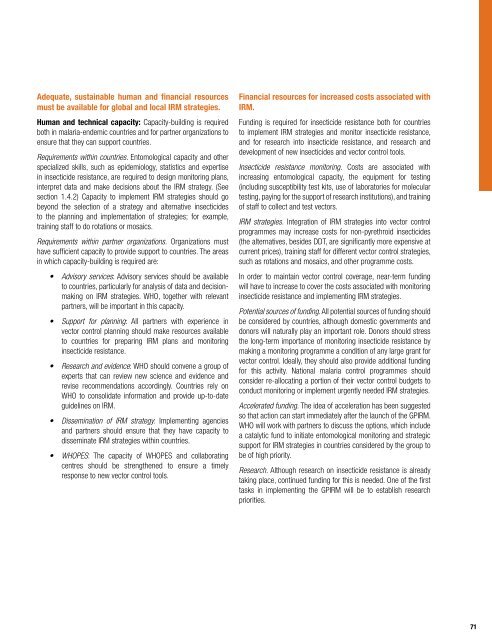Global plan for insecticide resistance management in malaria vectors
Global plan for insecticide resistance management in malaria vectors
Global plan for insecticide resistance management in malaria vectors
- No tags were found...
Create successful ePaper yourself
Turn your PDF publications into a flip-book with our unique Google optimized e-Paper software.
Adequate, susta<strong>in</strong>able human and f<strong>in</strong>ancial resourcesmust be available <strong>for</strong> global and local IRM strategies.Human and technical capacity: Capacity-build<strong>in</strong>g is requiredboth <strong>in</strong> <strong>malaria</strong>-endemic countries and <strong>for</strong> partner organizations toensure that they can support countries.Requirements with<strong>in</strong> countries. Entomological capacity and otherspecialized skills, such as epidemiology, statistics and expertise<strong>in</strong> <strong><strong>in</strong>secticide</strong> <strong>resistance</strong>, are required to design monitor<strong>in</strong>g <strong>plan</strong>s,<strong>in</strong>terpret data and make decisions about the IRM strategy. (Seesection 1.4.2) Capacity to implement IRM strategies should gobeyond the selection of a strategy and alternative <strong><strong>in</strong>secticide</strong>sto the <strong>plan</strong>n<strong>in</strong>g and implementation of strategies; <strong>for</strong> example,tra<strong>in</strong><strong>in</strong>g staff to do rotations or mosaics.Requirements with<strong>in</strong> partner organizations. Organizations musthave sufficient capacity to provide support to countries. The areas<strong>in</strong> which capacity-build<strong>in</strong>g is required are:• Advisory services: Advisory services should be availableto countries, particularly <strong>for</strong> analysis of data and decisionmak<strong>in</strong>gon IRM strategies. WHO, together with relevantpartners, will be important <strong>in</strong> this capacity.• Support <strong>for</strong> <strong>plan</strong>n<strong>in</strong>g: All partners with experience <strong>in</strong>vector control <strong>plan</strong>n<strong>in</strong>g should make resources availableto countries <strong>for</strong> prepar<strong>in</strong>g IRM <strong>plan</strong>s and monitor<strong>in</strong>g<strong><strong>in</strong>secticide</strong> <strong>resistance</strong>.• Research and evidence: WHO should convene a group ofexperts that can review new science and evidence andrevise recommendations accord<strong>in</strong>gly. Countries rely onWHO to consolidate <strong>in</strong><strong>for</strong>mation and provide up-to-dateguidel<strong>in</strong>es on IRM.• Dissem<strong>in</strong>ation of IRM strategy: Implement<strong>in</strong>g agenciesand partners should ensure that they have capacity todissem<strong>in</strong>ate IRM strategies with<strong>in</strong> countries.• WHOPES: The capacity of WHOPES and collaborat<strong>in</strong>gcentres should be strengthened to ensure a timelyresponse to new vector control tools.F<strong>in</strong>ancial resources <strong>for</strong> <strong>in</strong>creased costs associated withIRM.Fund<strong>in</strong>g is required <strong>for</strong> <strong><strong>in</strong>secticide</strong> <strong>resistance</strong> both <strong>for</strong> countriesto implement IRM strategies and monitor <strong><strong>in</strong>secticide</strong> <strong>resistance</strong>,and <strong>for</strong> research <strong>in</strong>to <strong><strong>in</strong>secticide</strong> <strong>resistance</strong>, and research anddevelopment of new <strong><strong>in</strong>secticide</strong>s and vector control tools.Insecticide <strong>resistance</strong> monitor<strong>in</strong>g. Costs are associated with<strong>in</strong>creas<strong>in</strong>g entomological capacity, the equipment <strong>for</strong> test<strong>in</strong>g(<strong>in</strong>clud<strong>in</strong>g susceptibility test kits, use of laboratories <strong>for</strong> moleculartest<strong>in</strong>g, pay<strong>in</strong>g <strong>for</strong> the support of research <strong>in</strong>stitutions), and tra<strong>in</strong><strong>in</strong>gof staff to collect and test <strong>vectors</strong>.IRM strategies. Integration of IRM strategies <strong>in</strong>to vector controlprogrammes may <strong>in</strong>crease costs <strong>for</strong> non-pyrethroid <strong><strong>in</strong>secticide</strong>s(the alternatives, besides DDT, are significantly more expensive atcurrent prices), tra<strong>in</strong><strong>in</strong>g staff <strong>for</strong> different vector control strategies,such as rotations and mosaics, and other programme costs.In order to ma<strong>in</strong>ta<strong>in</strong> vector control coverage, near-term fund<strong>in</strong>gwill have to <strong>in</strong>crease to cover the costs associated with monitor<strong>in</strong>g<strong><strong>in</strong>secticide</strong> <strong>resistance</strong> and implement<strong>in</strong>g IRM strategies.Potential sources of fund<strong>in</strong>g. All potential sources of fund<strong>in</strong>g shouldbe considered by countries, although domestic governments anddonors will naturally play an important role. Donors should stressthe long-term importance of monitor<strong>in</strong>g <strong><strong>in</strong>secticide</strong> <strong>resistance</strong> bymak<strong>in</strong>g a monitor<strong>in</strong>g programme a condition of any large grant <strong>for</strong>vector control. Ideally, they should also provide additional fund<strong>in</strong>g<strong>for</strong> this activity. National <strong>malaria</strong> control programmes shouldconsider re-allocat<strong>in</strong>g a portion of their vector control budgets toconduct monitor<strong>in</strong>g or implement urgently needed IRM strategies.Accelerated fund<strong>in</strong>g. The idea of acceleration has been suggestedso that action can start immediately after the launch of the GPIRM.WHO will work with partners to discuss the options, which <strong>in</strong>cludea catalytic fund to <strong>in</strong>itiate entomological monitor<strong>in</strong>g and strategicsupport <strong>for</strong> IRM strategies <strong>in</strong> countries considered by the group tobe of high priority.Research. Although research on <strong><strong>in</strong>secticide</strong> <strong>resistance</strong> is alreadytak<strong>in</strong>g place, cont<strong>in</strong>ued fund<strong>in</strong>g <strong>for</strong> this is needed. One of the firsttasks <strong>in</strong> implement<strong>in</strong>g the GPIRM will be to establish researchpriorities.71
















